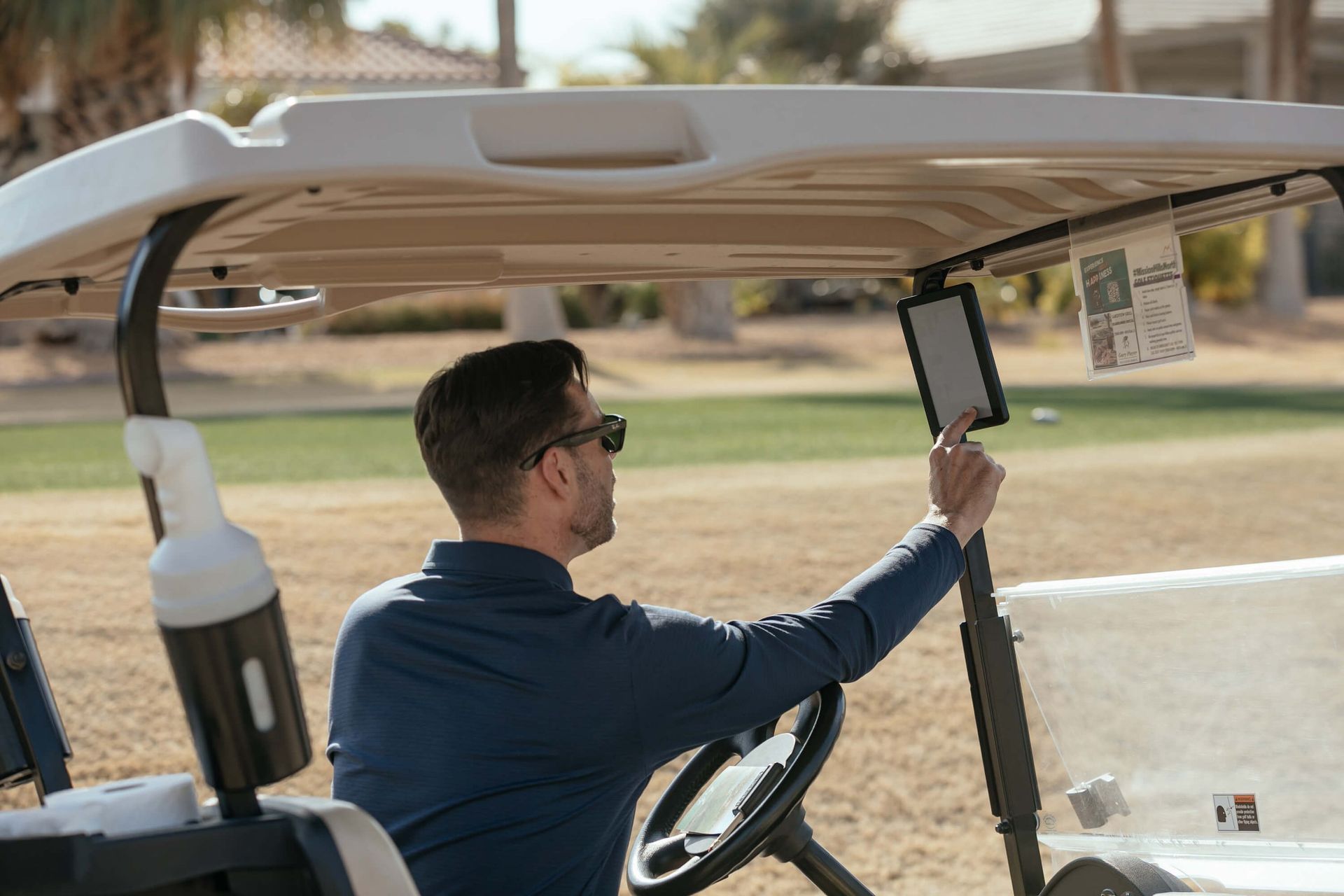April 24, 2025
Smart Fairways: How Golf Courses Are Using Technology to Revolutionize Course Management

From drones to data analytics, explore how the golf industry is turning tradition on its head with high-tech tools designed to streamline operations, elevate player experience, and protect the environment.

Golf is often thought of as a game steeped in history and tradition, where the rules haven’t changed much and the etiquette remains sacred. But behind the rolling greens and quiet fairways, a silent transformation is taking place. Golf courses around the world are embracing technology—not as a gimmick or novelty—but as a fundamental pillar in how they operate, maintain quality, and enhance the golfer’s experience. From satellite imagery to automated irrigation systems, the 21st-century golf course is a smart, data-driven environment that quietly reshapes the game’s future.
In this article, we’ll explore the many ways golf courses are incorporating modern technology, not only to optimize course maintenance and increase efficiency but also to make the game more engaging and sustainable.
The Evolution of Course Management
Traditionally, golf course management relied heavily on human experience, intuition, and manual labor. Groundskeepers would walk the course daily, relying on sight and touch to evaluate turf health. Weather tracking consisted of checking forecasts and hoping for the best. Inventory was managed by pen and clipboard. While effective to an extent, these methods were time-consuming and prone to human error.
The introduction of technology into golf course management has been gradual, but its impact is now unmistakable. Innovations across agronomy, data science, GPS, and cloud computing have enabled courses to collect, analyze, and act on data in real time. The result? Better playing conditions, reduced environmental impact, and more streamlined operations.
Precision Agronomy with Satellite Imaging and Soil Sensors
One of the most significant transformations has taken place beneath golfers’ feet. Turf management, once a blend of art and science, is now a tech-driven discipline guided by real-time data. Courses are increasingly using satellite imagery, aerial mapping, and in-ground soil sensors to monitor the health of their turf.
Soil sensors can provide continuous updates on temperature, moisture levels, salinity, and more. This allows grounds crews to spot problem areas before they become visible to the naked eye. Rather than applying water or fertilizer uniformly across an entire green or fairway, they can now tailor inputs precisely to the needs of each square foot.
Satellite imagery and drones complement this by offering high-resolution overhead views of turf health. Problem areas—like dry patches, disease, or pest infestations—show up clearly, allowing superintendents to act faster and with more accuracy.The result is a significant reduction in waste, healthier turf, and better playing conditions year-round.
Automated Irrigation and Water Conservation
Water is one of the most precious—and expensive—resources for golf courses. Managing it responsibly is not just an environmental imperative; it’s also a financial necessity. Enter smart irrigation systems.
Modern irrigation systems can be controlled remotely via mobile apps and web portals. They pull data from soil sensors, weather forecasts, and evapotranspiration models to deliver precisely the right amount of water at exactly the right time.
No more watering during rainstorms or over-saturating greens. These systems also use GPS-mapped zones to ensure that water is only applied where it’s needed, avoiding waste and runoff. Some systems even learn over time, using machine learning algorithms to adapt their watering schedules based on historical patterns and turf responses. For courses in arid climates or regions with strict water regulations, these technologies aren’t just useful—they’re essential.

Fleet Management and GPS-Enabled Maintenance
Managing a fleet of mowers, utility vehicles, and golf carts has also become more efficient through the integration of GPS tracking and telematics.
Maintenance crews can now monitor the location, usage, and condition of every piece of equipment in real time. This means they can reroute machinery to areas that need immediate attention, ensure regular servicing, and reduce downtime due to breakdowns.
Golf carts equipped with GPS not only guide players around the course but also feed data back to management. Course operators can track pace of play, prevent carts from entering sensitive areas, and even communicate directly with players via onboard screens. This dual use of GPS enhances the experience for players while giving course managers a valuable tool for maintaining flow and reducing wear on the course.
Environmental Monitoring and Sustainability
Courses today are under increasing pressure to minimize their environmental impact. To do so, many are using environmental monitoring technologies to track energy use, emissions, water quality, and more.
Weather stations, placed strategically around the property, feed continuous data into centralized systems. These stations track temperature, wind, humidity, and rainfall, allowing groundskeepers to fine-tune maintenance routines accordingly.
Other systems monitor water runoff for chemicals, ensuring that fertilizers and pesticides are not contaminating local water supplies. When issues are detected, they can be addressed before they become major problems—protecting both the environment and the course’s reputation.
Sustainability certifications, like Audubon International’s Cooperative Sanctuary Program, often require such technologies for compliance. Many top-tier courses now use these tools not just for accreditation, but as part of their brand identity.
Digital Tee Time Management and Member Engagement
Technology isn’t only transforming the back-end operations—it’s also changing the golfer’s experience. Online booking systems have become the norm, but modern platforms go much further.
Advanced tee sheet software integrates with CRM systems to provide personalized marketing, track player preferences, and manage dynamic pricing. Players can receive alerts about promotions, weather delays, or tournaments. Clubs can identify and engage high-value customers with targeted offers.
Some systems even offer AI-driven suggestions to fill underutilized tee times, maximizing revenue and improving member satisfaction.
On-Course Experience: Apps, Sensors, and Real-Time Data
Golfers now have access to a wealth of data while they play, thanks to mobile apps, smart watches, and even club-embedded sensors. Courses are integrating their own apps with real-time GPS data to offer flyover views, yardages, scorekeeping, and even ordering food at the turn.
Shot-tracking technologies allow players to see how they performed on specific holes over time. This isn’t just fun—it’s a powerful tool for improvement. Some courses integrate this data into coaching programs, offering customized tips based on actual performance metrics.
In tournaments, live scoring and video feeds are becoming standard, especially at higher-end clubs. This turns every round into a more engaging and connected experience.

Drones, Robotics, and the Future of Course Maintenance
Looking ahead, the next frontier in golf course technology is automation. Drones are already being used for aerial inspections, promotional photography, and even seeding or spraying applications. They can cover large areas quickly and provide detailed maps for planning maintenance.
Autonomous mowers and utility vehicles are also on the rise. These machines can be programmed to cut fairways, rake bunkers, or transport materials without human supervision. Some courses in Asia and Europe are already piloting fully robotic greenskeeping crews.
While the initial investment is high, the long-term savings in labor and maintenance are significant. And as labor shortages continue to affect many markets, automation may be the key to ensuring consistent course conditions.
Cybersecurity and Data Integrity in Golf Operations
With all this data flying around—from customer profiles to equipment analytics—cybersecurity is becoming a major concern. Courses that digitize operations must protect against data breaches, ransomware, and service disruptions.
Many golf management software platforms now offer built-in security features like encrypted databases, multi-factor authentication, and regular backups. Still, clubs must take proactive steps, including employee training, risk assessments, and third-party audits.
This is particularly important for clubs with member-only sections, online payment systems, or health-related data in their CRM tools.
Challenges and Considerations for Adoption
Not every course is racing toward digitization. For smaller or more traditional operations, the cost of upgrading can be prohibitive. There’s also a learning curve—many superintendents and staff members have spent decades mastering manual systems and may resist change.
To overcome this, tech providers are creating more intuitive platforms, offering training and support, and designing modular systems that can be scaled over time. Some courses choose to implement technology in phases—starting with irrigation or tee time management and expanding from there.
Return on investment is also a crucial consideration. The upfront cost of installing sensors, smart irrigation, or automated mowers can be high—but over time, savings on labor, water, fuel, and lost revenue due to poor course conditions often justify the expense.
The Future of Golf Course Technology
The game of golf is evolving—not on the scorecard or in the swing mechanics, but in the quiet systems working behind the scenes. Technology is becoming inseparable from course management, and the most forward-thinking clubs are those that treat it as an asset, not an afterthought.
From sustainability to player engagement, the digital transformation of golf course operations is reshaping the game in exciting ways. Tradition and innovation no longer need to be at odds. With smart tools and informed decisions, golf courses can remain beautiful, challenging, and deeply enjoyable—for generations to come.
As this trend continues, the green of the future may look the same to the player’s eye—but behind the scenes, it will be smarter, more sustainable, and more connected than ever before.
More from Fairway Control












